Newsletters, as we know them, have been around for a really long time (even longer if you think back to pre-email times). They’ve also been a mainstay of the Internet since its inception.
Newsletters have become a major content format among creators, partly due to their appeal to targeted interest groups and because email is the next best thing to social media for reaching audiences. It’s not unusual to be subscribed to 10 completely different newsletters – I'm probably subscribed to twice that number. Additionally, while platforms like Twitter or TikTok are at the mercy of ever-changing algorithms, your email list is something you own and control.
Newsletters are a great, low-cost way to build trust with your audience – and brands love sponsoring them because the communities they can create are very loyal. Growing an email list allows you to create a community off social media, what Jay Clouse calls moving your audience from discovery to relationship.
I'm increasingly convinced that premature growth on social media is an expensive mistake.
— Jay Clouse (@jayclouse) July 24, 2023
Here's why: If you're taking this creator thing seriously, growth in reach should lead to growth in revenue.
Social media platforms are Discovery Platforms that should be leveraged to grow…
It helps that they are considered a valid business to start, with newsletters being acquired for millions. Different creators approach newsletter content in different ways, but the process of starting one follows the same pattern. In this article, we’ll be sharing the steps to creating your own newsletter.
Define your goal for the newsletter
The reason you start a newsletter will define much of its journey – it's one of the most important steps before you even pick a platform. The “why” will determine the “what,” “where” and “how” of this new format. So, as you start, ask yourself:
- Audience Connection: Am I seeking a more intimate, direct way to communicate with my audience? What would it look like to have that deeper connection with my audience?
- Content Depth: Is there content I wish to share that requires a more in-depth, nuanced approach that doesn't fit well within the constraints of my current platforms? How would it change my content creation process?
- Monetization and Value Exchange: Am I seeking an alternative way to monetize my content? What kind of value could I offer my audience? How would I approach monetization?
- Platform Independence: How would it impact my content strategy to have a communication channel unaffected by third-party algorithms?
- Feedback Loop: How do I build a mechanism to get regular feedback, insights, and suggestions from my community to better align my content with their needs and interests?
Here's a template to determine how to start your own newsletter – you can get it in Canva too!
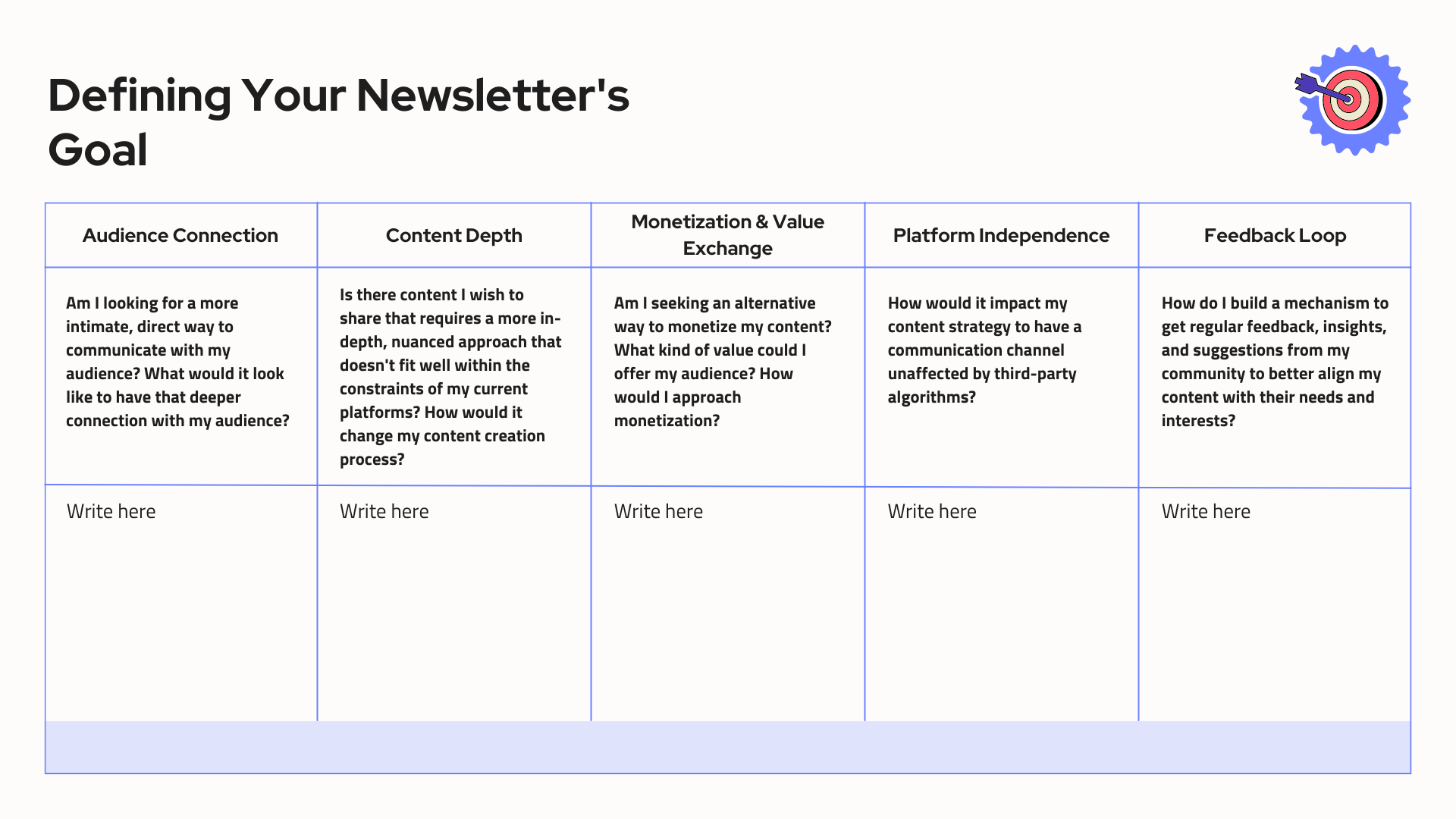
You don’t have all the answers before you start, but you do need to keep them in mind as you grow your newsletter.
Pick your niche and topic
No matter how you structure your newsletter, you must set clear expectations about what kind of content your subscribers can expect to receive when they sign up. Picking your niche for a newsletter is not the same as doing it for your social media – you need to determine beforehand what you’ll be saying and who you’ll say it to.
Try Jay Acunzo’s XY Premise Pitch exercise to find what will make your newsletter unique in a sea of similar creators.
“This is a newsletter about [your topic]. Unlike other newsletters about [your topic], only we [Unique Proposition].”
For example, “This is a newsletter about sustainable fashion. Unlike other sustainable fashion newsletters, only we focus exclusively on affordable, eco-friendly options for students.”
There are a million ways to approach a newsletter – Matthew McGarry broke them down into ten methods. From his breakdown, we can gather that there are two main categories of newsletters:
- Curated content: These newsletters aggregate existing content from several platforms and around the web for a specific niche. Although it may look simple, getting subscribers to a curated newsletter is quite difficult and usually requires you to offer add-ons like proprietary data or unique insights.
- Original content: These newsletters provide in-depth analysis and insights on a concept, industry, or even a single topic. This format can be challenging, but well-thought-out content, interested parties, and good marketing can win you a loyal audience in no time. Chenell Basillio has grown her newsletter, Growth in Reverse, to nearly 15,000 subscribers in less than a year by offering deep dives into how other creators grow their newsletters.
You’ll probably find yourself mixing both – many creators do. The key is to be differentiated and interesting enough to keep subscribers coming back and potential subscribers curious enough to give you their email.
Pick a platform
There’s no right or wrong answer to the platform to start your newsletter on, but as the options grow, it can be tough to decide. Here are some questions to consider when looking for a newsletter platform:
- How many subscribers can you have on a free plan?
- How easy is it to write and design a newsletter?
- How much does it cost as your newsletter grows?
- Does it have all the features you want for your newsletter experience?
- Is there an intuitive dashboard for tracking your analytics?
- How hard or easy is it to migrate off of?
- Are there proper spam filters in place to ensure successful email deliverability?
To help ease some of the stress, here are the three most popular options and what makes them great (or not) according to these questions – do any stand out to you?
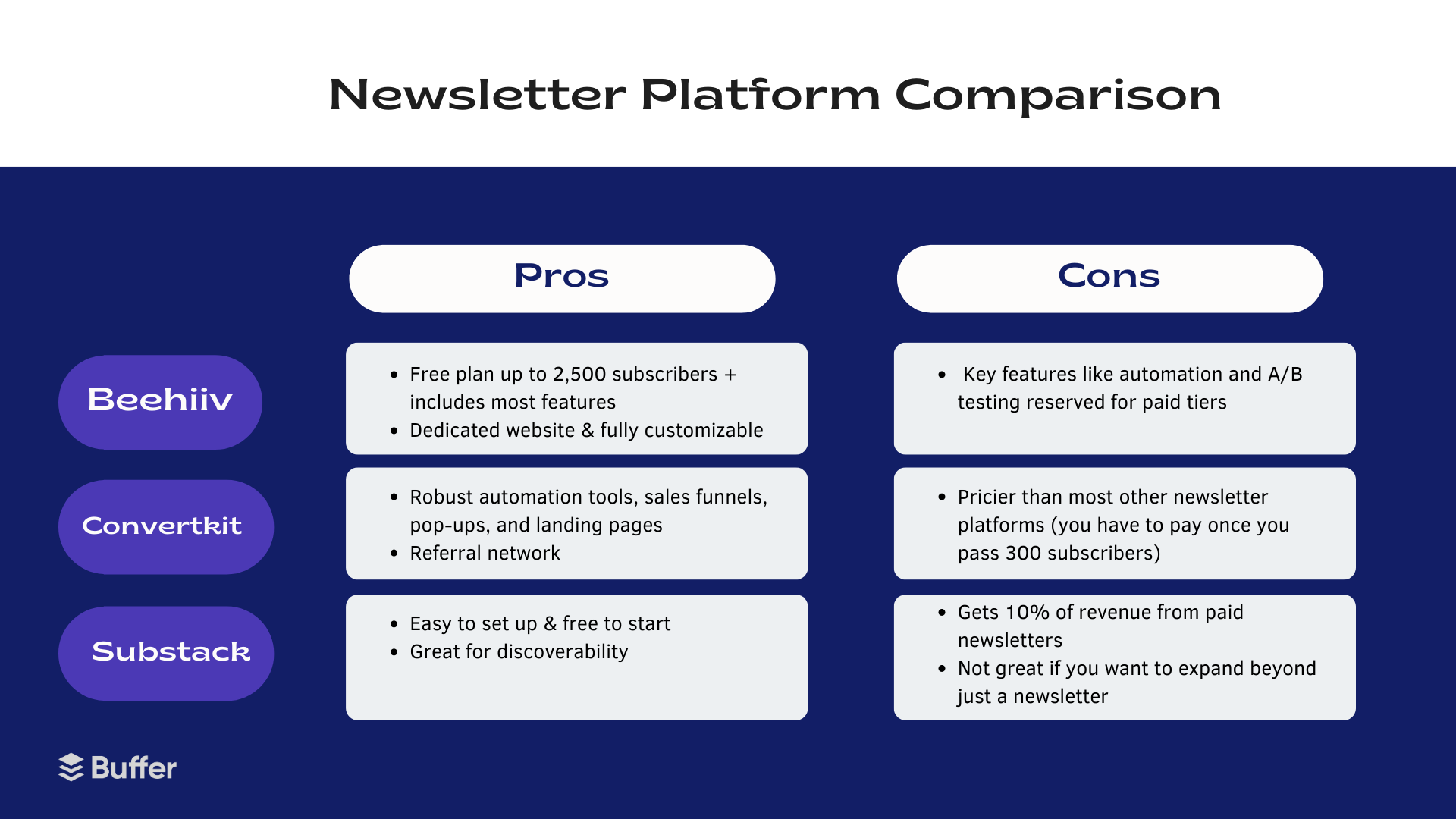
However, if you already have somewhere you publish content (a blog or website) that can start sending emails, that’s another option available to you. Ghost is a popular option among creators that also offers newsletter creation and publishing.
Next, let's explore some newsletter designs to inspire the aesthetic of your newsletter.
Pick a design
First impressions aren’t everything, but most people spend an average of 10 seconds on an email after opening it – so catching the eyes of your audience is more important than ever.
Platforms like Substack might have limited design features, but creativity knows no bounds. The Rhubarb Society uses vintage images and a muted beige background to match the lifestyle and fashion content they publish.
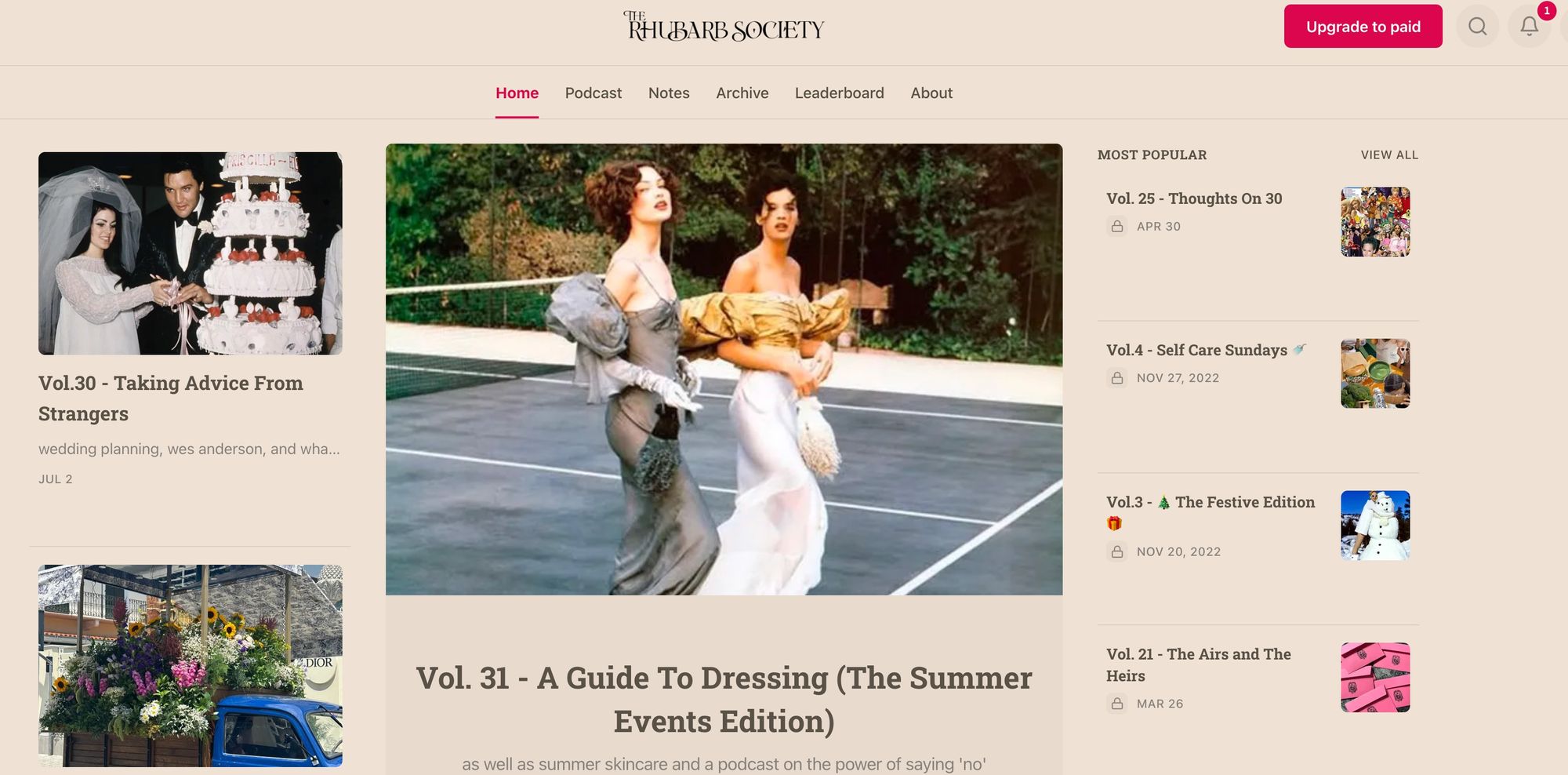
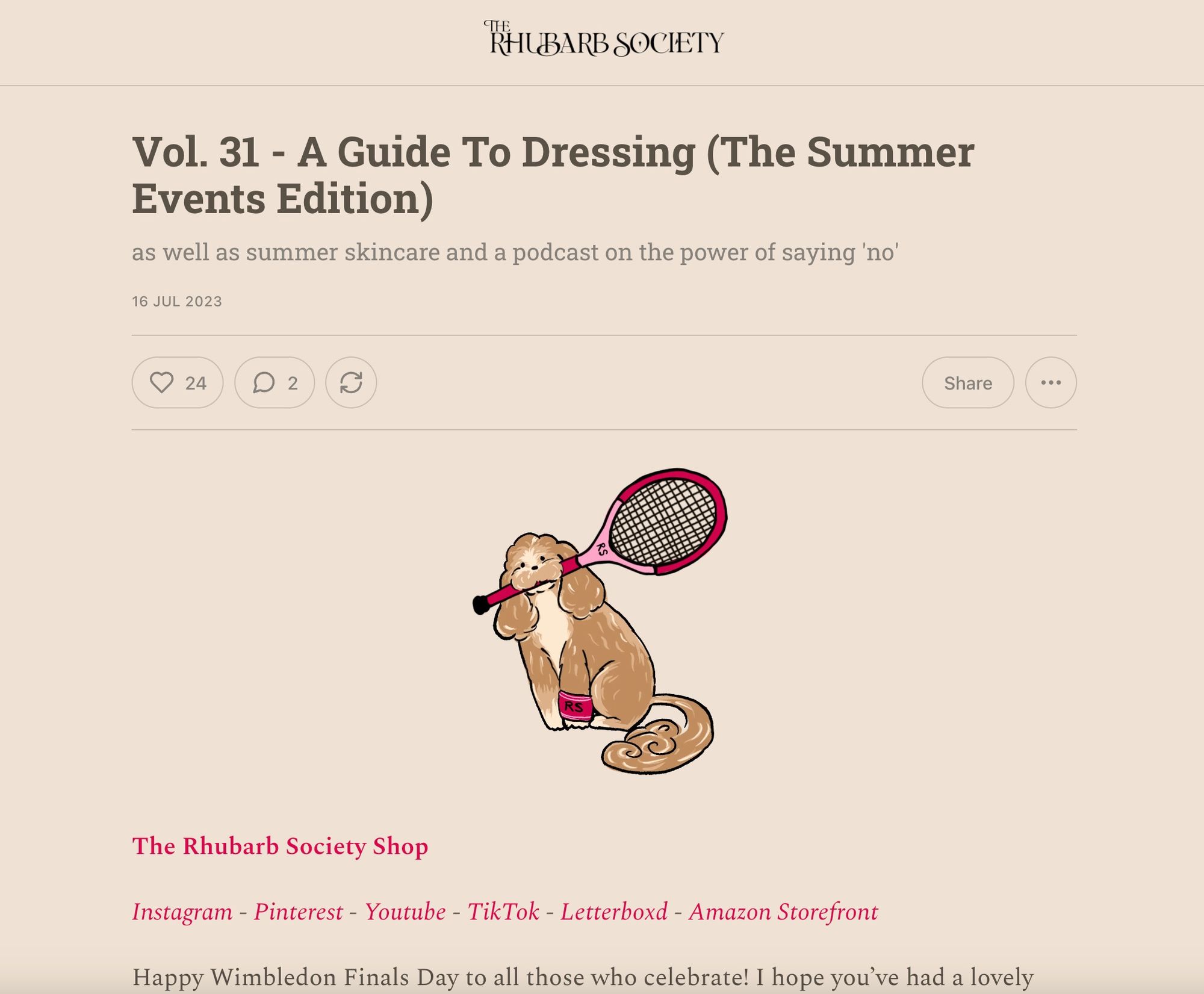
Use visually striking colors and motion graphics as header images to always stand out, like the AI newsletter Ponderer (whose founder offers Beehiiv design training).
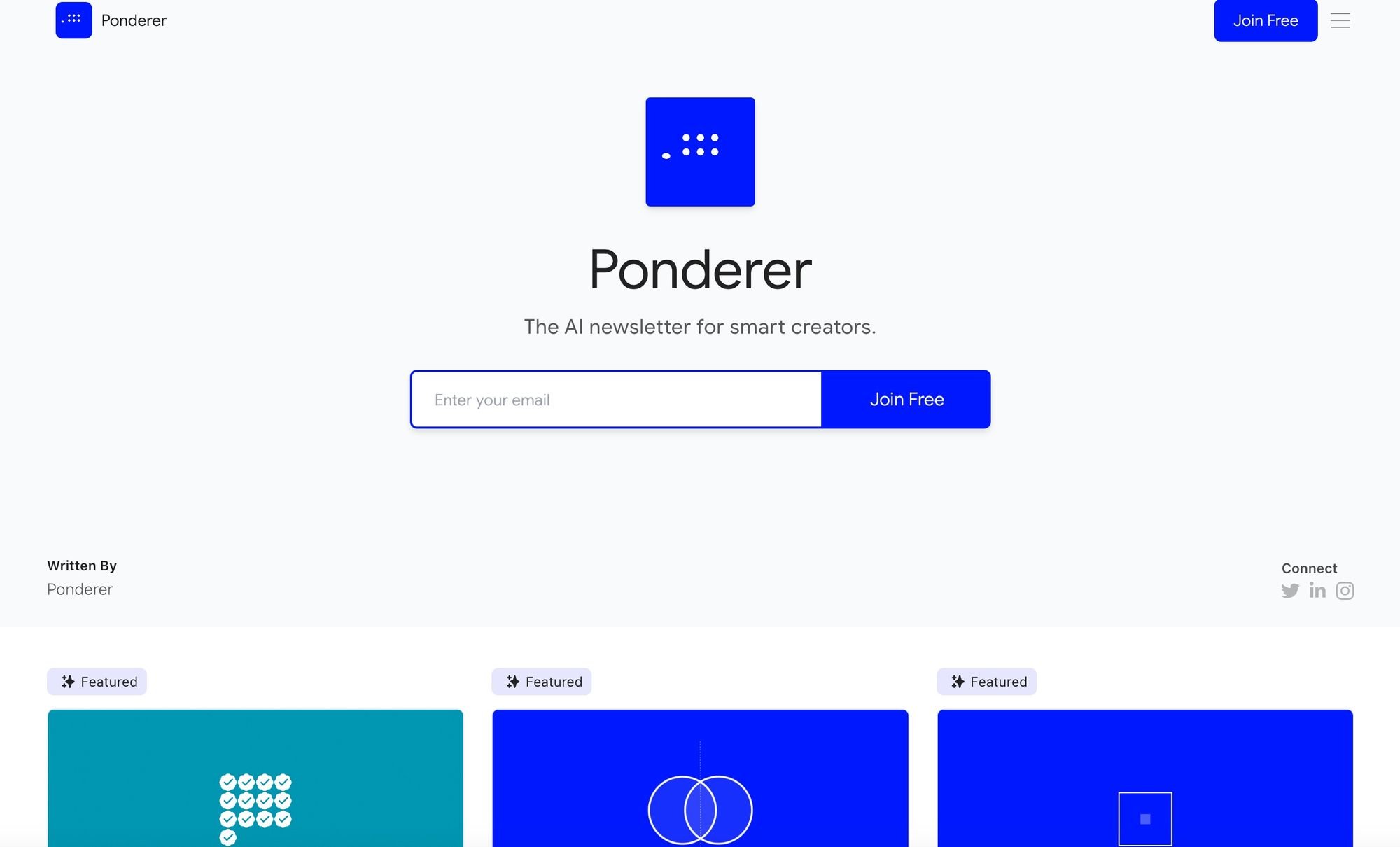
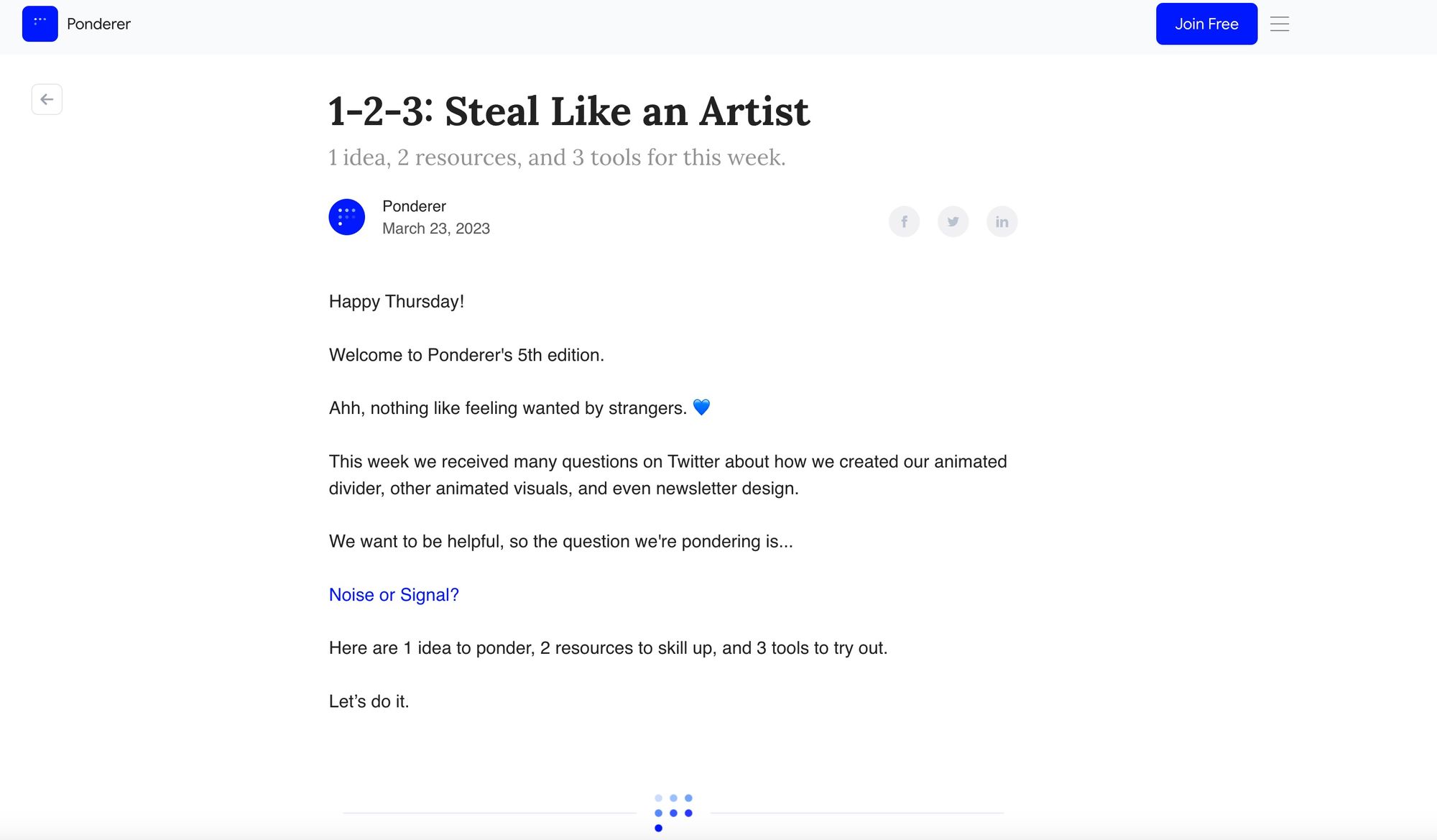
Or do a whole rebrand with custom and distinctive graphic line breaks, like VPLand did in a recent design update.
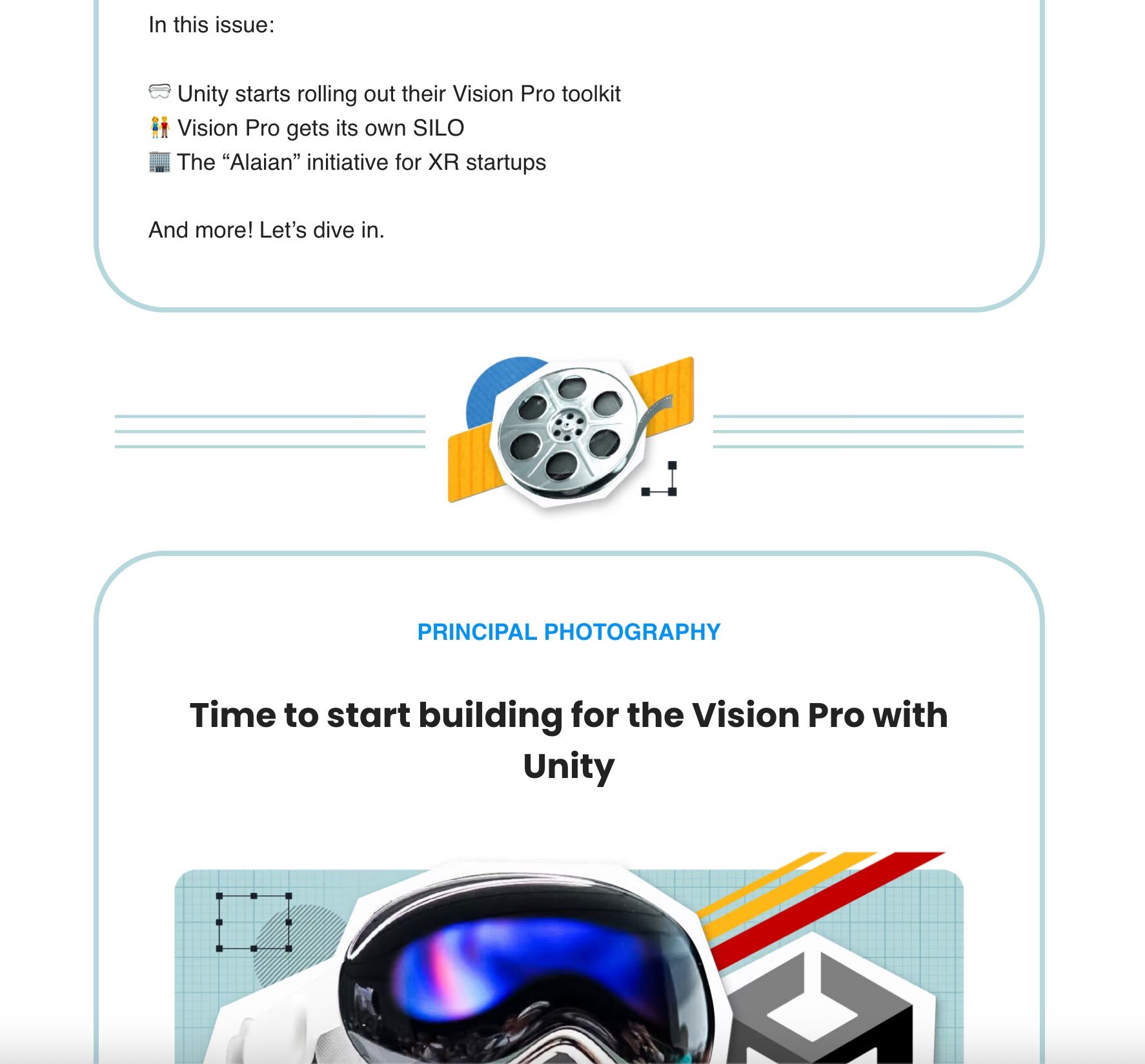
Beyond the look of your newsletter, the layout and format are also vital. Over half of all emails are opened on mobile devices, so prioritize the mobile experience.
Newsletter Design Tip
— Eric from Exploding ideas (@ericlamideas) July 21, 2023
Over half of all emails are opened on mobile. Ensure your newsletter design is mobile-friendly for the best reader experience.
Prioritize mobile > desktop pic.twitter.com/83zk02bLc8
Determine your strategy
Developing a strategy for your newsletter will help you accomplish two things: showing your audience how serious you are and keeping you accountable. Part of strategy is your:
- Publishing cadence: Frequency sets expectations. Whether you're sending your newsletter daily, bi-weekly, weekly, or monthly, deciding what’s manageable for you and considering what your audience would appreciate is crucial. If weekly feels right, but life gets in the way? No shame in adjusting to bi-weekly. However, it's not just about frequency but consistency. If your audience expects a monthly digest, ensure they receive it monthly or communicate otherwise – that’s part of trust-building.
- Content plan: What will you be publishing? Who are you writing for? Does it need to be planned out beforehand, or will you write the night before scheduling (this is me)? A newsletter for industry professionals will look different from one for casual enthusiasts. Tailor your content to meet the needs and interests of your readers.
- Distribution plan: How will you get your newsletter into your readers' hands (or inboxes)? Whether leveraging social media, cross-promoting with fellow creators, or optimizing your website's SEO for sign-ups, sketching a distribution strategy ensures your hard work gets the visibility it deserves.
The initial days of any venture are filled with experimentation – embrace it! Your strategy might evolve as you gauge your capacity, gather feedback, and grow your subscribers. That's the beauty of it — your newsletter, your rules.
Deliver your first issue
Your first newsletter issue isn't just an email; it's a statement. It's your grand entry, the opening note of your symphony. Here's how to make it resonate:
- Set the tone with authenticity: Introduce yourself and your vision for the newsletter. Readers appreciate knowing the human behind the content. Share a story, an anecdote, or what inspired you to start this journey.
- Pack a punch with quality: First impressions last. Your inaugural content should exemplify the value you aim to deliver consistently. Whether it’s an insightful article, a roundup of resources, or a personal reflection, ensure it stands out and speaks to your audience.
- Invite interaction: Encourage your subscribers to hit 'reply.' Whether they're sharing feedback, posing questions, or simply saying 'hello,' building a two-way dialogue from the start fosters a sense of community and belonging.
Remember, your first issue plants the seed for a blossoming relationship with your subscribers. Water it with passion, authenticity, and commitment.
Assess performance and start monetizing
If you find that a newsletter is a viable way to connect with your audience, you may take it more seriously and treat it like a business. And the goal of any business venture – even creative ones – is to generate revenue. Here are some ways newsletters do that:
- Sponsors: Partnering with relevant brands or companies can bring in sponsorships. In return, you can offer ad space or shoutouts in your newsletter issues. This is the most common monetization method amongst newsletters, with pricing ranging from as low as $10 to as high as $10,000 for an ad slot.
- Paid Subscriptions: If your content is premium and offers unique insights, consider having a tiered subscription model where basic content is free, but in-depth analyses or exclusive pieces are behind a paywall. This is another preferred option for many creators, as you can start by creating elaborate paid content and trim it down for your free subscribers.
- Affiliate Marketing: Recommend products or services and earn a commission for every sale made through your referral. Ensure that these recommendations align with your content and genuinely benefit your readers.
- Private community: You can start a private community that brings an even more engaged audience closer to you. Lia Haberman offers a private Slack community for the audience of social media marketers that read her ICYMI newsletter.
- Products: You could start offering digital and physical products to your audience that build on the niche or reputation you've built with your subscribers. Justin Welsh, who runs Saturday Solopreneur, sells a series of self-directed courses.
- Services and Consulting: As an expert in your field, offer consultation services or bespoke content solutions. Highlight case studies or testimonials in your newsletter to build trust. Katelyn Bourgoin, creator of Why We Buy, also offers strategy consultations.
- Events: Host exclusive events, webinars, or Q&A sessions for your premium subscribers. It can be an additional stream of revenue and a chance to interact directly with your readers. Jay Clouse offers sessions like these, including a live Newsletter Masterclass for his audience of creators.
Remember, while monetization is great, it's crucial to strike a balance so that monetization efforts don't overshadow the value provided to subscribers. Always prioritize delivering value to your subscribers so that the trust and loyalty you build will lead to sustainable revenue in the long run.
Newsletters are more than just a medium – they're a statement of your passion, expertise, and commitment to your readers. As you venture into this space, always prioritize authenticity, value, and community building. The digital world is constantly changing, but the need for genuine, impactful content remains constant. So, find your voice, share your insights, and build an outstanding newsletter.
Try Buffer for free
190,000+ creators, small businesses, and marketers use Buffer to grow their audiences every month.




